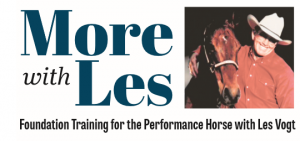![]()
 he most important ingredient to a stop is collection, and collection is achieved through weight reversal from the forehand to hindquarters. How does it happen? Something I haven’t talked about yet is that to me, horses have two motors. They have a front motor and a back motor. In other words, their front legs are motivated by one motor system and the back legs by another. That’s why a horse can be loping in front and trotting in back.
he most important ingredient to a stop is collection, and collection is achieved through weight reversal from the forehand to hindquarters. How does it happen? Something I haven’t talked about yet is that to me, horses have two motors. They have a front motor and a back motor. In other words, their front legs are motivated by one motor system and the back legs by another. That’s why a horse can be loping in front and trotting in back.
Consequently, the front legs can be slowed down, so they are carrying less of the weight, and the back legs sped up—they don’t have to be equal. So to collect a horse, we need to slow the front legs down and rev up the back legs. We might liken that to a cartoon character like Bugs Bunny, whose back legs are trying to pass the front, and the top line is round. We really only get that exaggerated in a sliding stop, but since that’s what we’re looking to achieve, developing the correct form is critical.
I went for years, easily 10 years, where I went to stop a horse by just pulling him. We hammered them. We ran ’em and ran ’em and stopped ’em and stopped ’em and then ran ’em again! And we had no idea that there was a proper form. Nobody talked about it; the bar just wasn’t that high yet, and we didn’t have that much structure in our western performance riding at that point. Now that we do, we can take many horses that would not have made it in that day and time and make them good stoppers, and we have a lot more fun—as do the horses, I’m sure!
So, what is the proper form for the stop? The horse needs to approach the stop with collection and power so that his top line is round and his hind legs are up under him. That way when he goes to stop, his hind legs are already reaching way up, and since he’s soft in the bridle, his back can just fold as he pushes his back legs into the slide.
The approach
So to approach a stop we have to have no resistance in the neck, the front legs have slowed down, we’re riding the back legs up to the front, and we’re getting some lift on top, or rounding of the back. The form has to stay consistent. Soon you will be able to feel the difference when your horse is correct. In fact, you’ll be able to see it in any horse that is approaching a stop. You will be able to tell, as I can, whether or not a stop will happen by the way the horse approaches it and by how he is moving.
And once you’re able to really feel that correct form, you’re going to need to insist on it every time. It’s not a matter of odds. Don’t think that you will get “lucky” and get a nice stop if the approach isn’t perfect. Don’t think you’ll get it again tomorrow just because you got lucky today. That’s the way we used to do it, but with what we know now, there’s no reason for it. You don’t have to just hope for a good stop; you can create it, but to do it, the approach has to be perfect.
Just like with everything else, there is a program for developing great stops on your horse, and the exercise we call the collected stop is the fi rst phase. This stop exercise is critically important because it is where you begin to teach your horse to stop with the correct form.
–Les
Les Vogt has won more than 15 World Championships, including two wins at the NRCHA Snaffle Bit Futurity. Today Les focuses is giving clinics around the world and developing products for the performance horseman. To learn more about Les and to see his clinic schedule, visit www.lesvogt.com.
Leave a Comment
All fields must be filled in to leave a message.